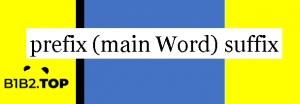
In Spanish, in English, and other languages around the world, there exists a combination of letters that when you connect them, become a new word (most commonly a monosyllable or disyllable). If we add them before or after the main Word, we change its meaning.
These grammatical structures are known as suffixes and prefixes; and in B1B2 we want to help you to master the universal language, or more commonly known as English, we will tell what «Prefixes and suffixes» are about.
In this post, we will use them and we will even compare them with their Spanish counterparts so that you can understand better what they are about.
Let’s get started!
First things first: What are prefixes and suffixes?
We begin this post with the definition, but every good definition should give a technical understanding of this grammatical form.
 We are learning a new language, and we need to practice it, but we also need to know the theory.
We are learning a new language, and we need to practice it, but we also need to know the theory.
- The prefixes are a set of letters that are added at the beginning of a word to change its meaning. You can find some prefixes that indicate repetition, that show opinion (positive or negative) of the narrator from that person’s point of view, other prefixes show temporality, and basically, their entire focus is to change the meaning of the main word.
Example: the word “dis” that means opposition or the negation of something.
Dis- agree
Dis- appoint
Dis- appear
- The «suffixes» are also a set of words that are added at the end of a word. The suffixes can also alter the meaning of the main word.
EXAMPLE: «ly» a very common suffix.
Quick – ly
Both the prefixes and the suffixes, form part of a grammatical structure known as “affixes”.
That’s all you need to know about their definition for now…
![]()
List of prefixes and suffixes

A picture is worth a thousand words… This is the reason why we shared this content with you.
If you wish to obtain more examples, or if you need to make a question, do not hesitate to contact us, and we will gladly help you.
Our common goal is to help you learn how to talk, write and use English as well as a native person does. We assure you that it is possible.
Rules for the use of prefixes and suffixes
Be careful with the meaning of «prefixes» and «suffixes»
As we know, we might come across a word that has more than one meaning (homograph words).
These exceptions do not stray away from the <>. That is why you have to know them, so you can use them according to the context, the sentence, and what you are trying to communicate.
For example, the prefix “im” might mean negation or inside of. Therefore, it will have a different meaning depending on the context and the word that will use the prefix.
Im- possible (negation)
Im- port (Related to bring something or put something inside of another thing)
This is just a small example.
- The prefixes are also used for quantities
In English and Spanish, this kind of event occurs.
The metric system, no matter which unit it uses, will always be accompanied by the following prefixes:
Mili
Centi
Kilo
Giga
Tera
Among other types of quantities that are used for the same purposes. You can memorize this rule because this phenomenon always happens.
- The main structure of the Word does not change with a prefix.
This affix must be added without altering the structure of the main Word.
For example: un- happy.
- The use of hyphens with the prefixes
The hyphens are used with the prefixes for different reasons.
- The first one is when it accompanies a proper noun, for example ex – boyfriend
- If we use the prefix self, it is mandatory that a hyphen has to be present between the prefix and the main word. Such is the case of self – love or self – esteem
- It is also used when the union of the prefix with the main word sounds similar to another word, that’s why they need to be differentiated.
Example: re-cover (to cover something again) This can be used to differentiate that word from the word “recover”, which means to recuperate (or heal).
- When the main Word is monosyllable and a suffix is added.
When this happens and the syllable is assembled by the following structure (consonant + vowel + consonant) the correct thing to do is to copy the last consonant for a second time and then add the suffix.
EXAMPLE:
Top-ping
Run-ning
But this is an exception. In most cases when a suffix is added, the main structure of the word is not altered.
These are some of the most common rules when we talk about prefixes and suffixes. For more details, you have the staff of B1B2, ready to help you at any time to help ease your learning process.
For now, let’s just concentrate on «prefixes and suffixes».

